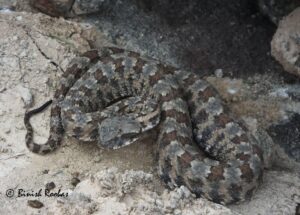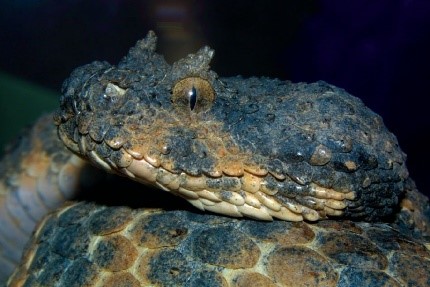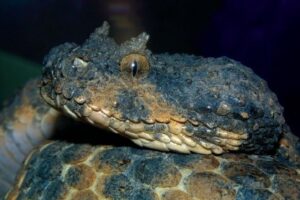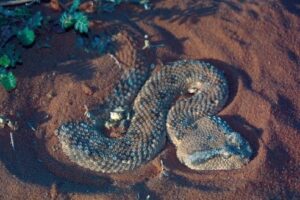Persiam Horned Viver or False horned viper
General Description

Credit: Broobas |

Credit: Zuhair, Stümpel, and Joger |
- Despite its serpentine body, its head is broad, flat, and it has short horns above its eyes.
- The fangs are folded like other snakes, but they lack a distinctive color pattern on their body and are often dark gray or tan in color.
- With a total length of 90 cm, it is the largest snake found in the UAE. Females are usually larger than males.
- The horned viper is very similar in appearance to the fake horned viper and is often referred to as a sand viper. The identification of these snakes causes some confusion, as some have horns while others do not have horns at all.
- The body is stocky, and the head is massive. It also has long, folded teeth and moves in an undulating manner in the soft sand, which is its favorite habitat.
Life Cycle and Common Characteristics
- It is oviparous, and sexually mature females lay 11-21 eggs. When produced, these already contain well-developed embryos, each of which can be as much as 8.5 cm in total length.
- Eggs hatch after only 30–32 days and measure 14 to 16 cm in total length.
- This snake species lives in the hills of the UAE. It is not found at altitudes less than 400 meters above sea level, and it does not venture out into the desert.
- They adapt well to the rocky environment they prefer.
- These snakes are found in the Emirates in the sandy deserts from the coast to the plains of the hills, where shade is not available.
- They are nocturnal reptiles and spend their days under anything that can provide them with a little protection from the glare of the sun. In the absence of shade, it buries itself in the sand by moving its ribs forward and upward at the same time, scattering the sand sideways, and allowing it to dive below the surface in a manner similar to a submarine. In a short time, she disappears, and only the eyes appear at the top of her head.
Damage and Medical Implication
- These snakes tend to avoid areas of human habitation.
- The venom of this snake exhibits strong hemorrhagic
- No antivenomis available for bites from this species.




